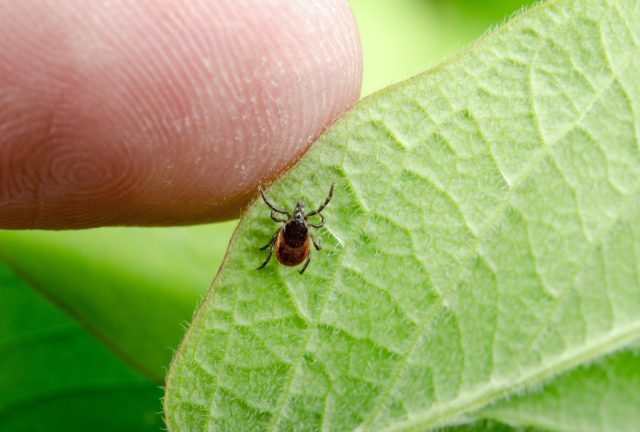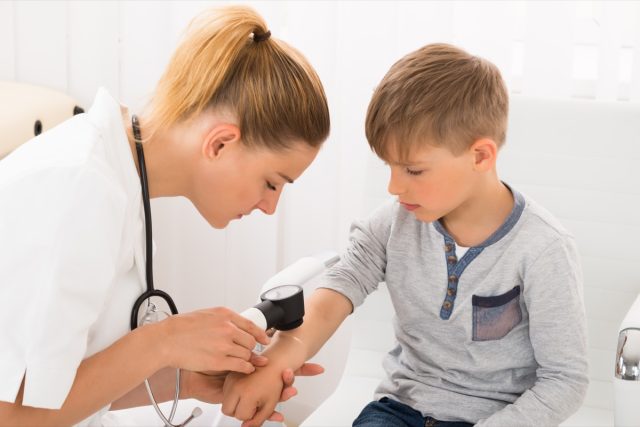If you spend time outside, especially in a grassy area or have pets, it’s important to be aware of ticks. Although the insect is tiny, they can cause serious health issues like lyme disease–a condition that affects an estimated 476,000 Americans and can cause a rash, joint pain and neurological problems. Eat This, Not That! Health talked with experts who explained everything to know about lyme disease. Read on—and to ensure your health and the health of others, don’t miss these Sure Signs You’ve Already Had COVID.


Dr. Andres Romero, MD, infectious disease specialist at Providence Saint John’s Health Center in Santa Monica, CA shares, “Lyme disease is a tick-borne illness, that means a human host acquires the infection after a bite from a tick. It is limited to certain regions in the country, predominantly the New England and mid-Atlantic areas, but cases have been reported in other regions. In order to transmit the infection the tick needs to be attached to the body for 24 hours or more. As expected, a person is more likely to acquire the infection during the summer months when outdoor activities are more common. Hence, if you live in a high incidence area, it is important to check all areas of the body for ticks after any outdoor activities to ensure none is attached.”
RELATED: If You Notice This on Your Body Have Your Heart Checked


According to Dr. Romero, “Frequently the initial symptom is a rash at the site of the bite that appears 7-14 days after the exposure. Not specific symptoms are also predominant including fatigue, poor appetite, joint aches and headaches. Some people may develop fever as well. Respiratory symptoms and gastrointestinal symptoms are unlikely with this condition. Other more severe symptoms tend to occur several weeks or even months later if the condition goes unrecognized, these include neurological symptoms like facial paralysis, meningitis and heart blockage (impairment of the electrical conduction of the heart). Less commonly it could also affect the eyes but this is rare.”
RELATED: What Taking Zinc Does For Your Body, Say Experts


Dr. Romero says, “Doxycycline is the antibiotic of choice and the key of treatment is early recognition of the infection so antibiotics are started early (before late complications have the chance to develop), hence it is important to consider this infection in high risk regions of the country after a potential exposure like hiking or any sort of activity that may imply contact with ticks. Testing for the infection is sometimes challenging for physicians not completely familiar with the infection, therefore advice from an infectious disease physician is recommended. One important fact about this infection is that long-term antibiotics have not been proven to be effective, treatment duration ranges from 7 to 21 days based on clinical presentation, treatment beyond that is not indicated. Physicians not familiar with the infection may recommend longer courses of antibiotics in lieu of a more extensive work-up looking for alternative causes for chronic fatigue or joint pains, common symptoms attributed to the so-called chronic Lyme disease.”
RELATED: If You Do This Every Morning, Get Checked For Diabetes


The Centers for Disease Control and Prevention states, “Where you live or vacation can affect your chances of getting Lyme disease. So can your profession and the outdoor activities you enjoy. The most common risk factors for Lyme disease include:
- Spending time in wooded or grassy areas. In the United States, deer ticks are found mostly in the heavily wooded areas of the Northeast and Midwest. Children who spend a lot of time outdoors in these regions are especially at risk. Adults with outdoor jobs also are at increased risk.
- Having exposed skin. Ticks attach easily to bare flesh. If you’re in an area where ticks are common, protect yourself and your children by wearing long sleeves and long pants. Don’t allow your pets to wander in tall weeds and grasses.
- Not removing ticks promptly or properly. Bacteria from a tick bite can enter your bloodstream if the tick stays attached to your skin for 36 to 48 hours or longer. If you remove a tick within two days, your risk of getting Lyme disease is low.”
RELATED: Signs You Have a Sleep Disorder, According to Neurologist


Dr. Dean Jacobs, M.D., F.A.A.P., board certified pediatrician at MemorialCare Medical Group in Santa Ana, CA and MemorialCare Orange Coast Medical Center in Fountain Valley, CA emphasizes, “Ticks love to hide on kids in and around their hair and their ears, under their arms, near their groin, between their legs and behind their knees, and around their waist. Ticks frequently prefer areas that are warm and damp. But some of their favorite hiding spots can be even tougher to find. Be sure to check your child’s belly button, on their clothing, and don’t forget to also check your child’s pet dog who came on the hike with you.”
RELATED: I’m an M.D. and This is the #1 Sign You Have a Heart Problem


According to Dr. Jacobs, “DEET works well as a tick repellent, and is applied directly on your child’s skin, but should never be used in children under 2 months of age. Higher concentrations of DEET prevent it for longer periods of time, but you should not use above 30%. All spray repellents should be applied in open areas to avoid breathing them in and should never be sprayed directly onto your child’s face. Remember to be sure to follow all directions on the label carefully. Permethrin is an alternative, which is applied to clothing instead of directly on the skin, especially on shoes, socks, and pant cuffs. While hiking outside, always wear closed-toed shoes with long-legged pants and long-sleeved shirts, and tuck the bottom of your child’s pants inside of their socks. Some of the best ways to prevent ticks are to also avoid areas where ticks are known to be most prevalent and to stay on the center of trails when hiking. Immediately do a full-body check for ticks, and have your child take a shower or bath after coming inside, to help eliminate ticks before they bite. Putting dry clothes in a dryer for at least 10 minutes on high heat, or up to 60 minutes on high heat if the clothes were wet, also helps kill ticks. The American Academy of Pediatrics notes that more studies are needed to determine if repellents with essential oils from lemon, eucalyptus, or soybean could be effective against ticks.”
RELATED: Surgeon General Just Issued Important COVID Update


“If you find a tick on your child, do not panic,” Dr. Jacobs exclaims. “If the tick is not attached to the skin and is not engorged, then it hasn’t bitten your child and you don’t need to worry. Even if it has bitten through, most tick bites do not end up spreading any disease at all, and the risk of your child getting Lyme disease is still very, very low. Second, note the color of the tick, take a high-resolution photo of it, and plan to try to keep the tick once it’s removed, as that information could help identify what type of tick it is.”
RELATED: Virus Experts Say Here’s When COVID is Coming “Back” to USA


Dr. Jacobs explains, “Remove the tick, while following these specific directions in order to do it right. Try covering the tick for at least 30 seconds with a cotton ball that has been soaked in liquid soap. Sometimes the tick will just stick to the cotton ball when you lift it away. If this fails, next hold clean sterilized fine-tipped tweezers parallel to the skin, and use the tweezers to grab the tick on its head as close to the skin as possible. Be careful not to grasp or squeeze the tick’s body. Pull the tick straight upward away from the skin without twisting or smashing it, until the tick releases its grasp. If the tick is not swollen and if it is tiny, instead it can be scraped off with the edge of a credit card. In either case, if any part of the tick breaks off in the skin, clean the skin with rubbing alcohol, and remove any large pieces with the sterilized tweezers. Once you remove the tick, wash your child’s wound with soap and water, and apply a topical antibiotic ointment. If there is a small bump or inflamed area from the bite, it usually starts to improve and go away within about 2 days. Do not use petroleum jelly, rubbing alcohol, nail polish, heat, or cold on the tick to get it to release, as that could make things worse. Again, if you do find a tick on your child, the most important thing is to not panic. The risk of your child getting Lyme disease is still less than 2%, and some statistics show that risk to be as low as 1.2% even in prevalent areas. Getting Lyme disease also depends on what type of tick it was, how long the tick was attached, and even your location and the time of year matter. It’s specifically the deer tick, also known as Ixodes, that causes Lyme disease. It is thought to have to be attached and fed for at least 36 hours before transmitting the infection. Deer ticks are brown in color and initially about the size of a pencil point, however they become engorged and much larger as they feed. Deer ticks that carry Lyme disease are most typically found in the Northeast and Mid-Atlantic states from Maine to Virginia, in the Midwest states bordering the Great Lakes, and in northern California. Lyme disease is most often transmitted in the late spring and early summer, and less often after that through the late fall.”
RELATED: Reasons Most People Gain “Too Much” Abdominal Fat


Dr. Jacobs explains, “You should bring your child to your pediatrician if you can’t remove the tick, if the tick was swollen, or if it was attached for at least 36 hours. You should also see your pediatrician if your child develops a rash called erythema migrans, which often looks like a bull’s-eye with a red-ring around the initial bite. Erythema migrans appears in about 80% of people who develop Lyme disease, it forms about 3 days to 30 days after the bite, it typically expands in size and becomes more red over time, and it may have one ring around the bite site or multiple rings. Also, bring your child in to be seen if your child has fever, headache, or widespread rash that starts within 2 weeks after the bite, if your child has facial weakness or droopiness, neck pain or stiffness, or if your child looks sick. When in doubt, make an appointment with your pediatrician, who can evaluate your child for Lyme disease, and determine if a prolonged course of antibiotics such as doxycycline or amoxicillin is appropriate.”
RELATED: Habits Secretly Increasing Your Blood Clot Risk, Say Physicians